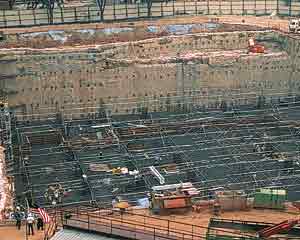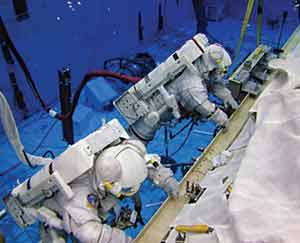Concrete Waterproofing with Crystalline Technology
Three Case Studies
The effective use of crystalline waterproofing technology products is illustrated by the following projects.
As an admixture
The triple tower development designed by architect Hijjas Kasturi as a new headquarters building for Maybank in Kuala Lumpur, Malaysia involved diaphragm wall construction, incorporating a nine level underground parking garage. A crystalline technology admixture was selected to control of the heat of hydration, reduce shrinkage cracking, give the slab enduring ‘self healing' capacity, waterproof the concrete, and increase strength and durability. Peak temperature for the first mass pour was approximately 69 degrees Centigrade, and the differential temperature was approximately 12 degrees Centigrade.
The basement slab required approximately 24,000 cubic meters of the admixture, dosed masscrete, or a large volume concrete pour. In September 1997, the initial pour of approximately 13,200 cubic meters was conducted over a 60-hour period. This project was the third largest continuous concrete pour conducted in the world, and the largest in Southeast Asia.
|
As an Applied Product
For the National Aeronautics and Space Administration (NASA) Neutral Buoyancy Tank, a two-coat application of white crystalline waterproofing was applied to the 50,000 sq. ft. Lab Tank. This tank is used to train astronauts for space walks necessary during construction of the space station. The white crystalline waterproofing treatment was chosen as a replacement for a white pool paint finish because of its longer life span and lower maintenance requirements. McDonnell Douglas performed the design work prior to their acquisition by Boeing.
As a Dry-Shake Application
The slabs of the a 110,000 sq. ft. distribution facility for Duracell in Cleveland, Tennessee, were waterproofed with a dry-shake application of crystalline waterproofing incorporating a floor hardener to increase the abrasion resistance of the floor to fork lift traffic.
|
Other Applications
The material produced in dry powder from crystalline waterproofing products reduces shrinkage and cracking to a wide range of other concrete elements. Crystalline technology can improve the performance of bagged mortar mixes, stuccos, and concrete. The performance of precast concrete panels, as well as precast elements, such as pipes, box culverts, and manholes can also be enhanced.
Conclusion
Although concrete may appear to be a simple product to put together, it requires a highly engineered approach. In an increasingly competitive design and construction environment, where high performance requirements, such as longer life cycles, more durable concrete, and value engineering are expected, careful consideration must be paid to basic requirements, such as the concrete, water, and cement ratio; cementing materials, and more sophisticated chemical admixtures.
Effective use of crystalline waterproofing technology will reduce the porosity and permeability of conventional concrete, and provide the high performance advantages and benefits that building owners and design professionals have come to rely upon in design and construction projects.











